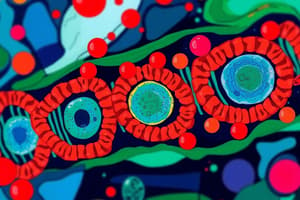Podcast
Questions and Answers
What is the primary function of the nuclear envelope?
What is the primary function of the nuclear envelope?
- Control exchange between the nucleus and cytoplasm (correct)
- Store genetic material
- Facilitate protein synthesis
- Provide structural support for the cell
Eukaryotic ribosomes have a higher Svedberg unit compared to prokaryotic ribosomes.
Eukaryotic ribosomes have a higher Svedberg unit compared to prokaryotic ribosomes.
True (A)
What are the two components that make up ribosomes by mass?
What are the two components that make up ribosomes by mass?
Ribosomal RNA (rRNA) and protein
The cell surface membrane is about ___ nm thick.
The cell surface membrane is about ___ nm thick.
Match the following cellular structures with their functions.
Match the following cellular structures with their functions.
Which type of ribosomes are found in mitochondria and chloroplasts?
Which type of ribosomes are found in mitochondria and chloroplasts?
The cell wall is made of phospholipids and is flexible.
The cell wall is made of phospholipids and is flexible.
What substance is primarily responsible for the rigidity of the plant cell wall?
What substance is primarily responsible for the rigidity of the plant cell wall?
What is the primary function of the rough endoplasmic reticulum (RER)?
What is the primary function of the rough endoplasmic reticulum (RER)?
The smooth endoplasmic reticulum (SER) is responsible for synthesizing proteins.
The smooth endoplasmic reticulum (SER) is responsible for synthesizing proteins.
What structures are formed by the membranes of the endoplasmic reticulum?
What structures are formed by the membranes of the endoplasmic reticulum?
The nucleolus is responsible for making __________ using its own DNA.
The nucleolus is responsible for making __________ using its own DNA.
What happens to the different parts of the nucleolus during nuclear division?
What happens to the different parts of the nucleolus during nuclear division?
Match the components of the endoplasmic reticulum with their functions:
Match the components of the endoplasmic reticulum with their functions:
Ribosomes are visible with a light microscope.
Ribosomes are visible with a light microscope.
What is the form of RNA used in the manufacture of ribosomes?
What is the form of RNA used in the manufacture of ribosomes?
Study Notes
Ribosomes
- Ribosomes are made of two subunits: a large and a small subunit
- The size of ribosomes is measured in Svedberg units (S), which indicate the rate at which substances sediment in a centrifuge
- Eukaryotic ribosomes are 80S, while prokaryotic ribosomes are 70S
- Mitochondria and chloroplasts contain 70S ribosomes, reflecting their prokaryotic origins
- Ribosomes are composed of roughly equal amounts of ribosomal RNA (rRNA) and protein
- Ribosomes function as the site of protein synthesis, bringing together mRNA, tRNA, amino acids, and regulatory proteins
Cell Surface Membrane
- The cell surface membrane is extremely thin, approximately 7 nm
- It has three layers: two dark layers surrounding a pale interior
- The membrane is selectively permeable, controlling the exchange of substances between the cell and its environment
Nuclear Envelope
- The nucleus is surrounded by two membranes forming the nuclear envelope
- The outer membrane of the nuclear envelope is continuous with the endoplasmic reticulum
- The nuclear envelope contains nuclear pores that regulate the movement of substances between the nucleus and the cytoplasm
- Substances leaving the nucleus through pores include mRNA, tRNA, and ribosomes
- Substances entering the nucleus through pores include proteins, nucleotides, ATP, and certain hormones
Cell Wall
- Plant cells are easily distinguished from animal cells due to their larger size and the presence of a cell wall
- The cell wall is an extra structure that lies outside the cell surface membrane
- The cell wall is rigid due to the presence of cellulose fibers, providing structural support and shape to the cell
Nucleolus
- The nucleolus appears as a darkly stained, rounded structure within the nucleus
- Its primary function is to manufacture ribosomes
- It contains DNA from one or more chromosomes, containing genes for ribosomal RNA (rRNA) and tRNA
- Less dense regions within the nucleolus are where ribosomal subunits are assembled, combining rRNA with proteins from the cytoplasm
- Larger cells with higher ribosome production have a larger nucleolus
- The nucleolus only exists during ribosome synthesis and disintegrates during nuclear division when synthesis ceases
Endoplasmic Reticulum
- The endoplasmic reticulum (ER) is a network of interconnected membranes that form flattened compartments called sacs or cisternae
- The ER separates processes occurring within the cisternae from the cytoplasm
- The ER facilitates the transport of molecules, primarily proteins, within the cell
- The ER is continuous with the outer membrane of the nuclear envelope
Rough Endoplasmic Reticulum (RER)
- RER is characterized by the presence of ribosomes attached to its surface
- It functions as the site of protein synthesis
Smooth Endoplasmic Reticulum (SER)
- SER lacks ribosomes and has a smooth appearance
- It is involved in the synthesis of lipids and steroids
- SER plays a role in calcium ion storage, crucial for muscle contraction
- In the liver, SER participates in drug metabolism
Studying That Suits You
Use AI to generate personalized quizzes and flashcards to suit your learning preferences.
Related Documents
Description
This quiz covers key concepts related to ribosomes, cell surface membranes, and the nuclear envelope. Explore the structure and function of ribosomes, the selectively permeable nature of cell membranes, and the composition of the nuclear envelope. Test your knowledge on these foundational cell biology topics!




